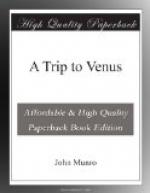G. “They would keep their gravity in losing it.”
I. “The car, meeting with practically no resistance in the ether, would tend to move in the same direction with the same velocity, and anything put overboard would neither fall nor rise, but simply float alongside. When the car came within the sensible attraction of the moon, its velocity would gradually increase as they approached each other.”
G. “Always supposing the aim of the gun to have been exact. You might hit the moon, with its large disc and comparatively short range, provided no wandering meteorite diverted the bullet from its course; but it would be impossible to hit a planet, such as Venus or Mars, a mere point of light, and thirty or forty million miles away, especially as both the earth and planet are in rapid motion. A flying rifle-shot from a lightning express at a distant swallow would have more chance of success. If you missed the mark, the projectile would wheel round the planet, and either become its satellite or return towards the earth like that of Jules Verne in his fascinating romance.”
I. “Jules Verne, and other writers on this subject, appear to have assumed that all the initial effort should come from the cannon. Perhaps it did not suit his literary purpose to employ any other driving force. At all events he possessed one in the rockets of Michel Ardan, the genial Frenchman of the party, which were intended to break the fall of the projectile on the moon.”
G. “If I recollect, they were actually fired to give the car a fillip when it reached the dead-point on its way back to the earth.”
I. “Even in a vacuum, where an ordinary propeller could not act, the bullet may become a prime mover, and co-operate with the gun. A rocket can burn without an atmosphere, and the recoil of the rushing fumes will impel the car onwards.”
G. “Do you think a rocket would have sufficient power to be of any service?”
I. “Ten or twelve large rockets, capable of exerting a united back pressure of one and a half tons during five or six minutes on a car of that weight at the earth’s surface, would give it in free space a velocity of two miles a second, which, of course, would not be lost by friction.”
G. “So that it would not be absolutely necessary to give the projectile an initial velocity of five miles a second.”
I. “No; and, besides, we are not solely dependent on the rocket. A jet of gas, at a very high pressure, escaping from an orifice into the vacuum or ether, would give us a very high propelling force. By compressing air, oxygen, or coal-gas (useful otherwise) in iron cylinders with closed vents, which could be opened, we should have a store of energy serviceable at any time to drive the car. In this way a pressure or thrust of several tons on the square inch might be applied to the car as long as we had gas to push it forwards.”




